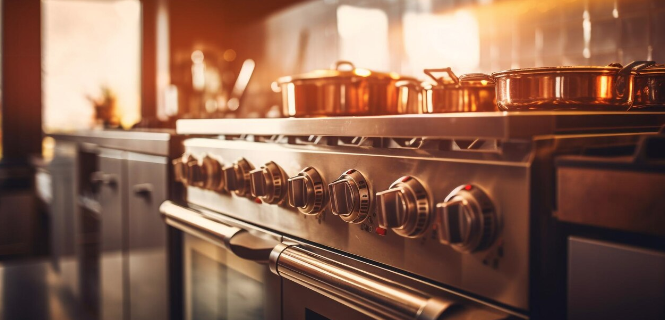Food safety is a critical aspect of any commercial kitchen, impacting both public health and business operations. Ensuring that food is handled, stored, and prepared safely requires the proper use of kitchen equipment. From refrigeration to cooking appliances, the right equipment helps maintain food quality, prevent contamination, and comply with health regulations. In this article, we’ll explore how kitchen equipment plays a pivotal role in upholding food safety standards.
1. Refrigeration: Preserving Food Quality
Refrigeration is one of the most essential pieces of kitchen equipment for maintaining food safety. Keeping perishable foods at the correct temperature slows the growth of harmful bacteria, reducing the risk of foodborne illness. Commercial refrigerators and freezers are designed to maintain consistent temperatures, even in the face of frequent door openings and heavy use.
The ideal temperature for most refrigerated items is below 40°F (4°C), while frozen foods should be kept at 0°F (-18°C) or lower. Advanced refrigeration units often include digital temperature controls, alarms for temperature fluctuations, and self-monitoring systems that alert staff to any potential issues. These features allow kitchen staff to ensure that food is always stored in a safe environment, significantly reducing the risk of spoilage and contamination.
2. Cooking Equipment: Ensuring Proper Cooking Temperatures
Cooking equipment is another cornerstone of food safety in commercial kitchens. Undercooked food can harbor harmful pathogens such as salmonella, E. coli, and listeria, which can cause severe illness. To prevent this, kitchen equipment such as ovens, grills, fryers, and stovetops must consistently reach and maintain the appropriate cooking temperatures.
For example, poultry should be cooked to an internal temperature of at least 165°F (74°C), while ground beef must reach 160°F (71°C). Using kitchen equipment equipped with built-in thermometers or smart cooking technology helps ensure that food reaches the correct internal temperature, eliminating harmful bacteria and ensuring it is safe to serve. Additionally, many commercial ovens and grills have precise temperature controls that help chefs avoid undercooking or overcooking, leading to both better food quality and improved safety.
3. Sanitation Equipment: Keeping the Kitchen Clean
Cleanliness is a fundamental part of maintaining food safety standards, and the right kitchen equipment plays a vital role in sanitation. High-temperature dishwashers, pot washers, and commercial sanitizers are specifically designed to eliminate bacteria, grease, and food particles from dishes, utensils, and cookware. These machines use a combination of heat and sanitizing chemicals to thoroughly clean items, ensuring that they are free from contaminants that could potentially spread harmful bacteria.
Additionally, many kitchen surfaces are made from stainless steel, a material that is both durable and easy to clean. This is essential in preventing the buildup of bacteria on prep tables, countertops, and other frequently used areas. Regular cleaning of kitchen equipment, combined with the use of sanitizing chemicals, helps maintain a hygienic environment and reduces the risk of cross-contamination.
4. Storage and Preparation: Preventing Cross-Contamination
Cross-contamination is a leading cause of foodborne illness, occurring when harmful bacteria are transferred from one food or surface to another. Proper kitchen equipment helps prevent this by separating raw and cooked foods during preparation and storage. For instance, color-coded cutting boards and knives are commonly used in commercial kitchens to keep different food types separate, reducing the risk of cross-contamination.
Similarly, sealed storage containers help prevent bacteria from spreading between foods in refrigerators and pantries. Organizing food storage with airtight containers and labeling systems ensures that ingredients are kept safely separated, reducing the chance of allergens or contaminants coming into contact with other foods. Proper organization and use of kitchen equipment in food prep areas are essential to maintaining food safety standards.
5. Modern Technology: Enhancing Food Safety with Smart Equipment
Advances in kitchen equipment technology have significantly enhanced food safety practices. Smart kitchen appliances now offer greater control and monitoring capabilities, helping to reduce the risk of human error in food handling. Smart refrigerators, for example, can monitor temperature fluctuations and alert staff if conditions become unsafe. These advanced systems can even provide real-time data, ensuring that kitchen staff are constantly aware of food storage conditions.
Similarly, automated cooking equipment can program precise cooking times and temperatures for various dishes, ensuring consistent food preparation and minimizing the risk of undercooked food. Some modern equipment even includes self-cleaning features, making it easier to maintain hygiene and food safety without added manual labor. The integration of technology into kitchen equipment ensures that food safety practices are more reliable and easier to enforce.
6. Compliance with Food Safety Regulations
Maintaining food safety standards is not just a best practice—it’s also a legal requirement. Kitchen equipment plays a critical role in ensuring compliance with food safety regulations, such as those set by the Food and Drug Administration (FDA) and local health departments. Inspections often focus on the condition and maintenance of kitchen equipment, ensuring that it is functioning correctly and being cleaned properly.
Equipment that is poorly maintained or used improperly can result in violations, fines, or even the closure of a business. Regular maintenance checks and cleaning schedules are necessary to keep equipment in good working condition and ensure compliance with food safety regulations. Investing in reliable kitchen equipment and keeping it well-maintained can help businesses avoid costly penalties and ensure that they are meeting the highest food safety standards.
Conclusion
In any commercial kitchen, the role of kitchen equipment in maintaining food safety cannot be overstated. From ensuring proper refrigeration and cooking temperatures to supporting sanitation practices and preventing cross-contamination, the right tools and appliances are essential in protecting both consumers and businesses. As technology continues to advance, modern kitchen equipment offers new ways to enhance food safety, providing greater control, monitoring, and efficiency.
By investing in high-quality, well-maintained kitchen equipment and staying up-to-date with the latest safety technologies, foodservice businesses can ensure they meet regulatory requirements and provide safe, high-quality food to their customers. Ultimately, the equipment used in the kitchen serves as the foundation for maintaining food safety standards at every step of the process.
